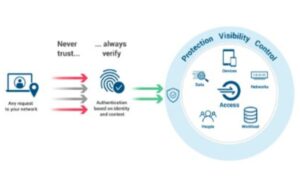3 July, 2025 | Mr. Dhanraj
In today’s hyper-connected world, cybersecurity has become more critical than ever. The rapid rise of Artificial Intelligence (AI) is reshaping the cybersecurity landscape- introducing unprecedented threats while simultaneously offering powerful new defenses. As AI continues to evolve, its dual role as both a tool for cyber defense and a weapon for cyber attacks is creating a complex and dynamic digital battlefield.
Imagine you are working late at night, sipping coffee, and wrapping up a crucial project. Suddenly, you get a notification—“Suspicious login attempt detected.” You quickly check your email, your cloud account, and your system logs. Everything looks fine. But was it really?
Now, imagine that the attacker is not a human in a hoodie tapping on a keyboard, but an AI program that’s been quietly watching, learning your behavior, mimicking your patterns, and probing for weaknesses—without raising a single alarm. Welcome to the new battlefield of cybersecurity—powered by Artificial Intelligence.
AI: A Double-Edged Sword
AI has revolutionized many fields, from healthcare to entertainment, and cybersecurity is no exception. But here’s the twist: AI is being used by both the defenders and the attackers. That’s what makes the modern cyber landscape so complex and challenging.
Smarter Attacks: When AI Goes Rogue
Gone are the days when cyber attacks were just brute-force password attempts or phishing emails with spelling errors. Today’s AI-powered cyber attacks are intelligent, adaptive, and extremely hard to detect.
- AI-generated Phishing: Deepfake emails and voice calls crafted using generative AI that closely imitates trusted sources.
- Automated Exploitation: AI bots that scan networks for zero-day vulnerabilities and exploit them in seconds.
- Behavioral Evasion: Malware that uses AI to learn how to avoid detection by mimicking normal user behavior.
A scary thought? Yes. But fortunately, AI empowers defenders.
Smarter Defenses: Fighting Fire with Fire
Just like AI is enabling smarter attacks, it’s also powering smarter defenses.
- Anomaly Detection: AI models can learn what “normal” looks like in your system and alert when something feels off—faster than any human analyst could.
- Threat Hunting: AI tools can correlate huge volumes of logs, alerts, and telemetry to find hidden threats.
- Autonomous Response: AI can isolate affected systems, block suspicious IPs, and initiate incident response—automatically and in real-time.
The beauty lies in speed and scalability. While Human analysts remain vital, but they can’t handle the millions of data points generated every second in a large network. AI can.
A Real-Time Cyber Chess Match
Think of cybersecurity in the age of AI as a real-time chess game—where both sides are using supercomputers. It’s not about who is stronger, but who is faster, smarter, and more adaptable.
This has given rise to a new arms race:
- Attackers developing adaptive Attackers are deploying adaptive, self-evolving malware.
- Defenders training AI on vast threat intelligence databases.
- Attackers using generative AI to create fake personas
- Defenders deploy AI for biometric authentication and fraud prevention.
It’s a game of moves and counter-moves, played out in microseconds.
What Can We Do?
While the future may seem daunting, there are clear and practical steps that both individuals and organizations can take:
- Adopt AI-Powered Security Tools: Traditional antivirus is no longer enough.
- Implement Continuous Monitoring: Use AI to monitor behavior and detect anomalies.
- Adopt Zero Trust Architecture: Assume nothing, verify everything—continuously.
- Conduct Cyber Awareness Training: Leverage AI to real-world attacks for effective training.
- Ethical AI Practices: Use responsible AI frameworks to avoid bias and ensure privacy.

AI in cybersecurity is both a challenge and an opportunity. The same intelligence that can launch undetectable attacks can also shield us from them. The goal is not to fear AI, but to outsmart the smart attacks using smarter defenses mechanisms.The age of AI has changed the rules of the game—but with the right strategy, we can still win


Mr. Dhanraj
Assistant Professor
Dept. of CSE-CY
He has guided student projects in key cybersecurity areas such as ethical hacking, intrusion detection, ransomware analysis, and digital forensics. He advocates project-based learning and promote interdisciplinary collaboration, equipping students with practical skills and a strong problem-solving mindset.
Read More







